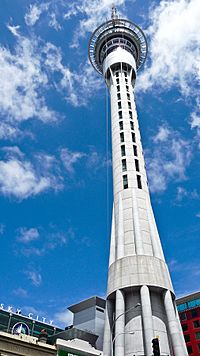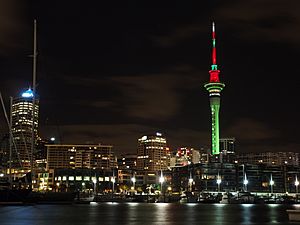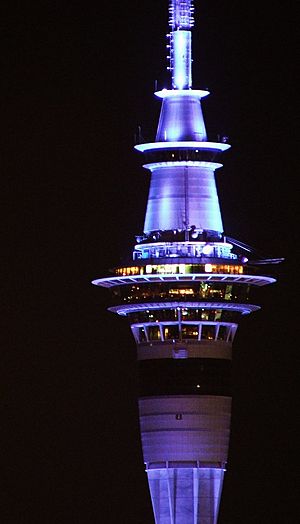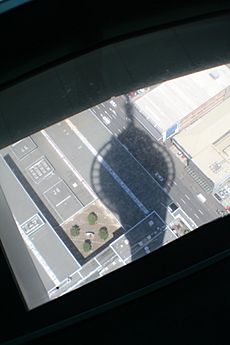Sky Tower (Auckland) facts for kids
Quick facts for kids Sky Tower |
|
|---|---|

The tower within the SkyCity Auckland complex
|
|
| General information | |
| Status | Complete |
| Type | Communications, observation, mixed use, tourism |
| Location | Auckland CBD, Auckland, New Zealand |
| Address | Corner Victoria and Federal Streets |
| Coordinates | 36°50′54″S 174°45′44″E / 36.8484°S 174.7621°E |
| Construction started | 1994 |
| Completed | 1997 |
| Opening | 3 August 1997 |
| Cost | NZ$85 million |
| Owner | Skycity Entertainment Group |
| Height | |
| Antenna spire | 328 m (1,076.1 ft) |
| Roof | 237 m (777.6 ft) |
| Top floor | 222 m (728.3 ft) |
| Observatory | 220 m (721.8 ft) |
| Technical details | |
| Floor area | 5,500 m2 (59,202 sq ft) |
| Lifts/elevators | 4 |
| Design and construction | |
| Architect | Craig Craig Moller Ltd. |
| Developer | Harrah's Entertainment |
| Structural engineer | Beca Group |
| Main contractor | Fletcher Construction |
The Sky Tower is a super tall building in Auckland, New Zealand. It's used for sending out TV and radio signals, and it also has amazing views! You can find it in the middle of Auckland city.
It stands at about 328 meters (1,076 feet) tall from the ground to the very top. This makes it the tallest building in the Southern Hemisphere! It's also one of the tallest towers in the whole world. Because it's so tall and looks so cool, it's a famous part of Auckland's skyline.
The Sky Tower is part of the SkyCity Auckland complex, which includes a casino. It was built between 1994 and 1997. Many of the top floors are open to visitors. About 1,150 people visit the tower every day!
Contents
Exploring the Sky Tower: Fun Things to Do
The Sky Tower has several levels you can visit. Each one offers something special:
- Level 50: Sky Cafe – A great spot for a quick bite.
- Level 51: Main Observation Deck – Enjoy amazing views from here.
- Level 52: Orbit 360° Dining – A restaurant that slowly spins around.
- Level 53: The Sugar Club restaurant, SkyWalk and SkyJump – More dining and thrilling activities.
- Level 60: Sky Deck – The highest observation deck.
Dining with a View
The top part of the tower has two restaurants and a cafe. One of them is New Zealand's only revolving restaurant. It's about 190 meters (623 feet) up and turns all the way around every hour. Imagine eating your dinner while the city slowly spins around you!
There's also a buffet restaurant one floor above the main viewing area.
Amazing Observation Decks
The Sky Tower has three different viewing decks. Each one gives you 360-degree views of Auckland.
The main viewing level is 186 meters (610 feet) high. It has special glass floor sections that are 38 millimeters (1.5 inches) thick. You can look straight down to the ground – it's a bit scary but super cool!
The highest viewing deck is called "Skydeck." It's just below the main antenna, at 220 meters (722 feet) up. From here, you can see up to 82 kilometers (51 miles) away on a clear day.
Thrill-Seeking Adventures
If you're feeling brave, you can try the "SkyJump." This is a 192-meter (630-foot) jump from the observation deck. You can reach speeds of up to 85 kilometers per hour (53 mph)! Don't worry, guide cables keep you safe from hitting the tower.
You can also do a "SkyWalk" around the outside of the tower. For special tour groups, it's even possible to climb into the antenna mast, reaching heights of 300 meters (984 feet)!
How the Sky Tower Helps with Signals
The Sky Tower is not just for fun; it's also very important for telecommunications and broadcasting. It helps send out TV and radio signals across Auckland.
The top part of the tower has the world's largest FM radio signal combiner. This works with 58 wireless microwave links. Together, they provide many services, including television, wireless internet, and weather measurement services.
The tower is the main FM radio transmitter for Auckland. It also helps broadcast digital television to parts of the city. Many radio stations and television channels broadcast from the Sky Tower.
Building the Sky Tower
Building such a tall tower was a huge project!
Project History
Fletcher Construction was the company that built the Sky Tower. The engineering company Beca Group helped with the design and planning. Gordon Moller of Craig Craig Moller architects designed the tower. It even won awards for its design!
The tower took two years and nine months to build. It officially opened on August 3, 1997.
Facts About Construction
The Sky Tower is made of very strong reinforced concrete. The main part of the tower, which is 12 meters (39 feet) wide, holds four lifts and an emergency staircase. This part stands on eight "legs" that go deep into the ground.
The upper levels are made from strong, lightweight materials, steel, and concrete. The observation decks are covered in aluminum and blue-green glass. A steel frame supports the very top mast.
During construction, workers used a lot of materials:
- 15,000 cubic meters (19,600 cubic yards) of concrete.
- 2,000 tons (2,200 short tons) of reinforcing steel.
- 660 tons (728 short tons) of structural steel.
The mast at the very top weighs over 170 tons (187 short tons)! It was too heavy for a helicopter, so a special crane was used to lift it into place. Then, another crane was built on the tower itself to take apart the first crane. Finally, that second crane was taken apart into small pieces that could fit into the elevator!
Safety Features
The Sky Tower is built to be very safe. It can handle winds stronger than 200 kilometers per hour (124 mph). It's designed to sway up to 1 meter (39 inches) in very strong winds.
For safety, the lifts in the Sky Tower have special technology. They can sense if the tower is swaying too much because of strong winds. If it sways a lot, the lifts will automatically slow down. If the sway goes beyond a safe level, the lifts will go back to the ground floor and stay there until the winds calm down.
The Sky Tower is also built to withstand a big earthquake, up to an 8.0 magnitude, if it happens close by. There are three special fireproof rooms on levels 44, 45, and 46. These rooms are safe places to go in an emergency. The central lift shaft and stairwells are also designed to be safe from fire.
Lighting Up the Sky Tower

The Sky Tower often lights up in different colors to support various groups and charities. Here are some examples of how it's lit:
- Blue = Auckland Blues (a rugby team)
- Pink = Breast Cancer Awareness Month or Mother's Day
- Red & Green = 'Kidz First' Children's Hospital or Christmas
- Red, Orange, Yellow, Green, Blue, Purple, Pink, Gold & White = New Year's Eve
- Red & Gold = Chinese New Year
- Blue & Green = Starship Children's Foundation or Earth Day
- Orange = Auckland Festival or 40 Hour Famine
- Green & Purple = The Auckland Cup (a horse race)
- Red, White & Pink = Valentine's Day
- Green = St. Patrick's Day
- Red = ANZAC Day (with a Poppy image)
- Green, Red & White = Rally New Zealand
- Gold = New Zealand Olympic Team (when they win a gold medal)
- Blue & Red space = Matariki (Māori New Year)
- Red, Orange, Yellow, Green, Blue and Purple = Pride Month
- Blue & Orange = Easter
- Blue, White & Red = Waitangi Day (New Zealand's national day)
- Orange, Purple & Green = Halloween
- Green base and yellow top = Daffodil Day (for Cancer Society New Zealand) or FIFA World Cup
- Red and white = Māori Language Week
- White = White ribbon awareness (to stop violence)
- No lighting (except aircraft warning lights) = Earth Hour or a day to remember important people who have passed away.
Energy-Saving Lights
The top half of the Sky Tower uses energy-efficient LED lights. These lights replaced older ones in 2009. The LEDs can make millions of different color combinations! The old lights used 66% more energy than the new LED system. The bottom half of the tower also got new LED lights in 2019.
Saving Energy for New Zealand
Sometimes, New Zealand needs to save electricity, especially in winter. This is because a lot of the country's power comes from water levels in lakes. To help save power, SkyCity sometimes turns off the tower's decorative lights, leaving only the red aviation lights. This helps remind everyone to save energy.
The Sky Tower also uses wall lights for special events, like having an LED Santa for Christmas!
Special Events and Challenges
The Sky Tower is often used for fun and challenging charity events.
Stair Climb Challenges
The Leukemia and Blood Foundation of New Zealand holds yearly fundraising stair climb challenges. One famous event is the "Firefighters Sky Tower Stair Challenge." Firefighters from all over New Zealand race up 1,108 steps of the tower! Climbing the Sky Tower stairs is like running a "vertical marathon."
Tower de Force Competition
The Sky Tower also hosts the "Tower de Force" competition every year. This event includes climbing 1,226 steps of the tower. It also has other military skill tests that change each year. People from the RNZAF, RNZN, New Zealand Army, and New Zealand Police take part. This competition raises money for many charities.
Images for kids
-
The tower illuminated in Christmas colours. Various other lighting schemes and colours are also used.
See also
 In Spanish: Sky Tower para niños
In Spanish: Sky Tower para niños








